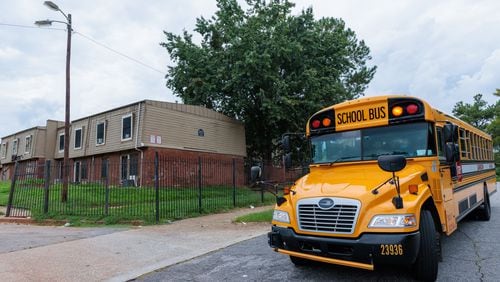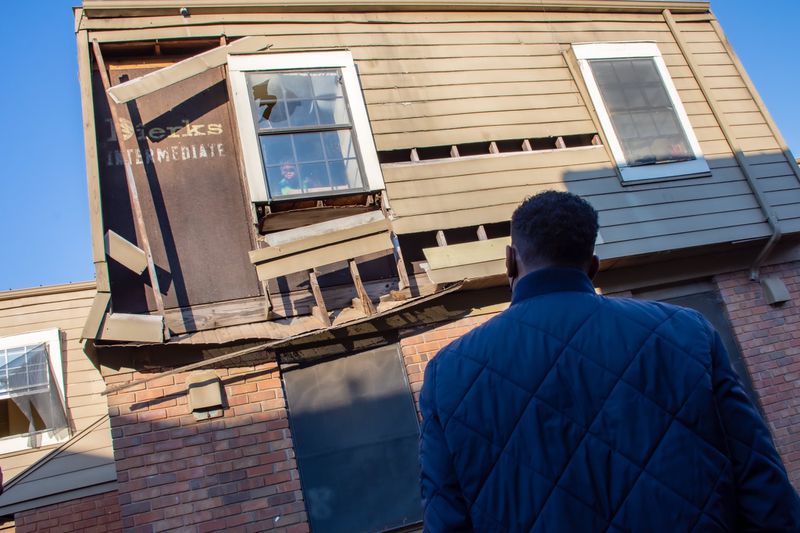When the derelict Forest Cove apartment complex shuttered its doors and residents were relocated by the city, the Thomasville Heights neighborhood lost a lot more than some of its residents.
Thomasville Heights Elementary School was closed after a large portion of the school’s students were among the relocated residents — leaving streets often bustling with children after school empty.
The loss of residents and boarded up Forest Cove apartment complex only added to the dumping issue, community members say, that already plagued the area’s vacant land.
But amidst a rocky relocation of Forest Cove residents to new housing and a hefty legal battle brewing between the city of Atlanta and complex owner Millennia, hope for a revitalized Thomasville Heights community remains.
Community members, City Council and Mayor Andre Dickens administration have OK’d a multi-year plan to build hundreds of affordable housing units, spur commercial development and revamp the neighborhood’s infrastructure.
Atlanta City Council member Jason Winston said the plan aims to revitalize one of Atlanta’s most historic Black communities.
“It means a lot for folks that have lived there for a long time that want to see progress and want to be able to enjoy that progress,” he said.
According to the city, a staggering 57% of the neighborhood’s residents fall beneath the poverty line, while 97% of the population is Black.
The neighborhood as it is today was shaped in the 1950s through urban renewal. Both the now-demolished Thomasville Heights housing project and the Forest Cove development were built in the late 1960s and early 1970s as housing for low-income Black families.
Credit: City of Atlanta
Credit: City of Atlanta
Rampant violent crime at Forest Cove was mentioned in The Atlanta Journal-Constitution’s series “Dangerous Dwellings,” about unsafe and unsanitary apartment complexes in metro Atlanta.
In October, U.S. Sen. Jon Ossoff, chairman on the Congressional human rights subcommittee, launched an investigation in coordination with the Department of Housing and Urban Development into “abuse of renters by landlords,” specifically citing Forest Cove as an example.
The embattled complex and unused land in the area acquired by the city of Atlanta plays a key role in plans for the neighborhood’s development going forward.
“The impetus of this plan was that in relocating folks who had lived in Forest Cove, the city wanted to do everything that was within our power to be able to bring people back to the Thomasville Heights community,” Winston said. “It’s a very tight knit community.”
The lengthy Thomasville Heights Revitalization plan was crafted over the course of months by both community stakeholders, urban planners and the city. It calls for both residential and commercial development on city-owned land and the demolition of the Forest Cove complex to make way for new housing units.
Joshua Humphries, the mayor’s housing policy advisor, said that the city was able to identify over 80-acres of publicly-owned land in the neighborhood which allows the city significant flexibility in the development process.
“Our goal here is two-fold: we want Thomasville to be a great place to live, no matter your income,” he said. “And for former Forest Cove residents to have a home back in Thomasville Heights if they choose to move back.”
Credit: arvin.temkar@ajc.com
Credit: arvin.temkar@ajc.com
The redevelopment plan calls for Forest Cove to be demolished and replaced with 756 apartments, 34 townhomes and additional accessory dwelling units.
Land containing the Mt. Nebo Baptist Church at the intersection of Moreland Avenue and McDonough Boulevard is earmarked for another 258 apartments, 20 townhomes and over 84,000 square feet of commercial development space.
Winston said the next step in making the sweeping plan a reality is for City Council to make necessary zoning adjustments for redevelopment. The successful development of Atlanta’s Summerhill neighborhood after the Atlanta Braves relocated to Truist Park is a model for what he wants to see happen in Thomasville Heights, Winston said.
“We want to make sure that no one was permanently displaced from this community, and that those that want to come back will have an opportunity to come back,” he said. “That’s what this plan is all about.”
While the city looks to make the Thomasville Heights revitalization plan a reality, Millennia has filed its own lawsuit against the city.
The federal suit portrays Millennia as the victim of a ploy by the city to strip it of Forest Cove, so the property can be redeveloped in violation of its Fifth Amendment rights to fair compensation when a government takes private property.
“I hope (Thomasville residents) are able to return to the neighborhood,” Kurt Lentz, attorney for company, said in October when Dickens announced the city’s lawsuit against Millennia. “The city has a plan a very defined plan of what they want Thomasville heights to look like. And it doesn’t involve the type of affordable housing that Millennia was providing in the neighborhood.”
About the Author




